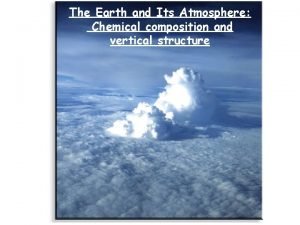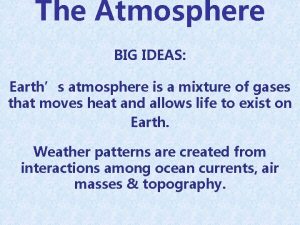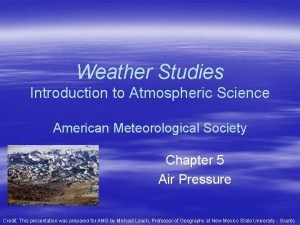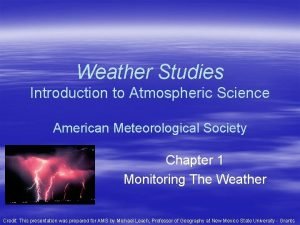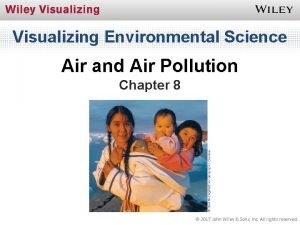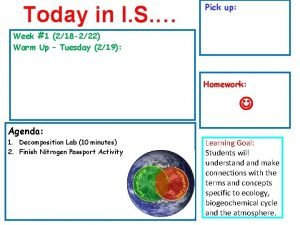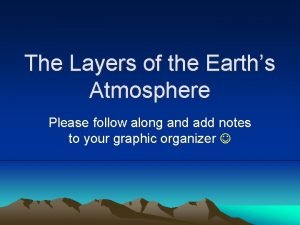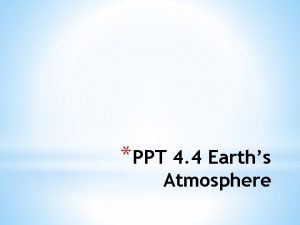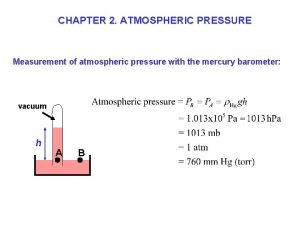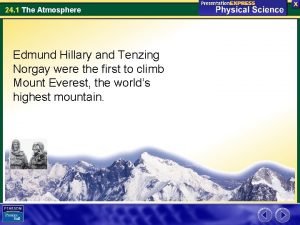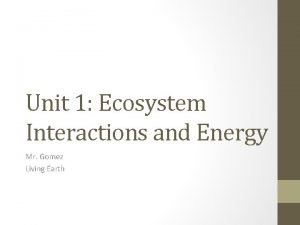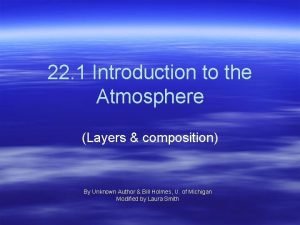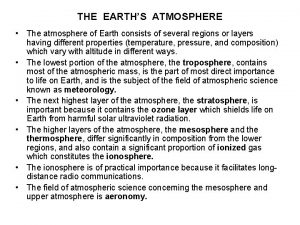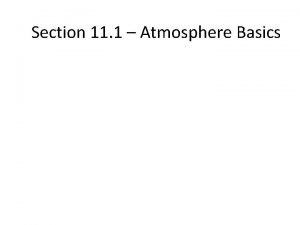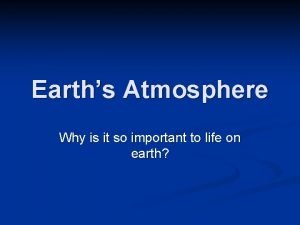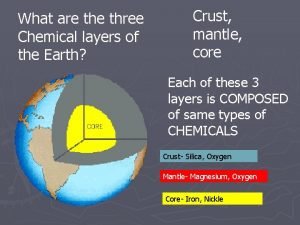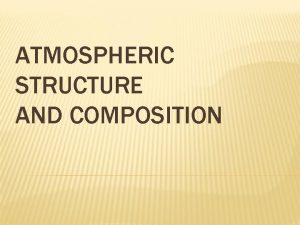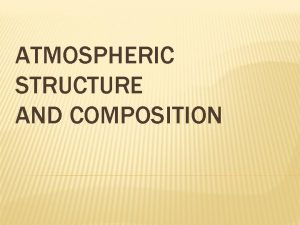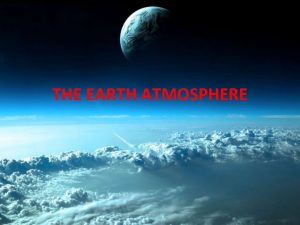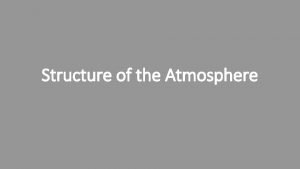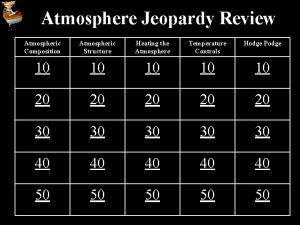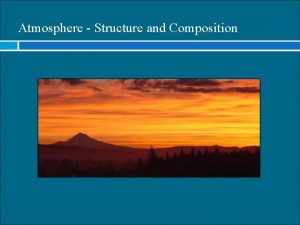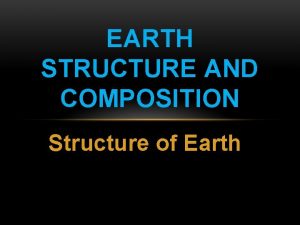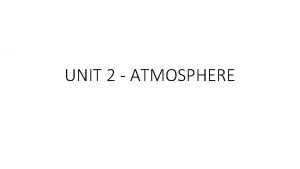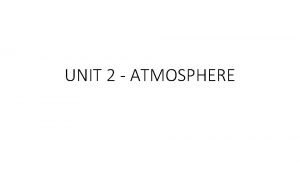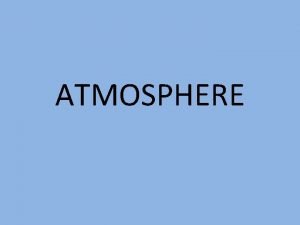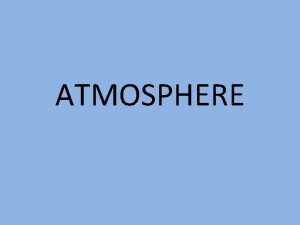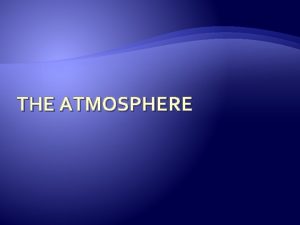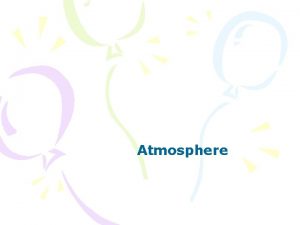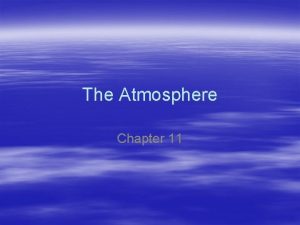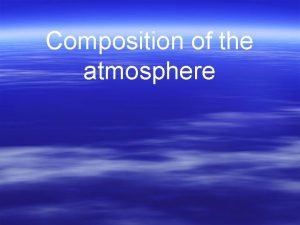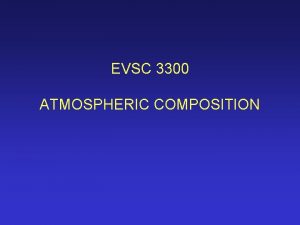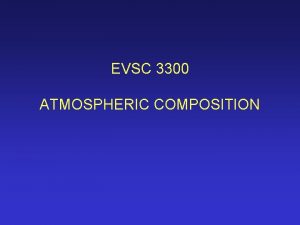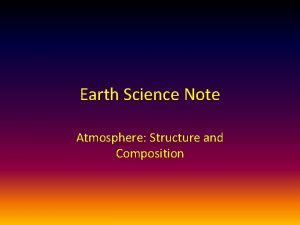Earth Science Atmospheric Composition and Structure The Atmosphere





















- Slides: 21

Earth Science Atmospheric Composition and Structure

The Atmosphere The atmosphere is the envelope of gases that surround our planet It is a very thin layer compared to the radius of the Earth We refer to this layer informally as “air” The majority of the energy that drives the atmosphere is from the Sun. The atmosphere receives most of this energy from the surface. Imbalances of energy drive the winds. Eventually, all energy degrades down to friction.

State of the Atmosphere We commonly express the state of the atmosphere by measuring it using the following variables: Pressure Temperature Wind Humidity Cloud cover Precipitation type and amount Visibility (distance one can see horizontally)

Types of Measurements Contact Measurements – Also called insitu measurements; A measurement that is conducted by sticking a probe into the medium being measured (thermometer). Remote Sensing – A measurement conducted by remote means and not from directly within the medium being measured (satellites).

Weather is the state of the atmosphere at a particular time and a particular place. An example of weather information would be the temperature at Stevensville, MT today at 7 p. m.

Climate is the long-term state of the atmosphere at a particular location. Can be expressed as averages and extremes. “Normal” conditions is simply a 30 -year average of that particular variable. Examples of climate information would be: The normal high at Missoula, MT on August 1 is 83 degrees. The record amount of precipitation at Missoula MT on August 1 is 0. 55 inches back in 1961.

More Definitions Meteorology is the study of the Earth’s atmosphere, its motions and behavior Climatology is the study of the Earth’s climate, its past and future

Atmospheric Composition Dry air (neglecting water vapor) is composed of the following gases: Nitrogen (N 2) = 78% Oxygen (O 2) = 21% Argon (Ar) = 1% Trace Gases Dust, bacteria, and other particulates

Atmospheric Composition Trace Gases that are only found by examining a million or billion air molecules Examples include: Carbon Dioxide (CO 2) = 340 ppmv Neon (Ne) = 18 ppmv Helium (He) = 5 ppmv Methane (CH 4) = 2 ppmv Hydrogen (H 2) = 0. 5 ppmv

Atmospheric Molecules Note that the Oxygen, Nitrogen, and Hydrogen that we breathe are not single atoms of that gas, but instead are two atoms of that gas bonded together in what is called a diatomic molecule. Ozone is an example of a triatomic molecule with three oxygen atoms.

Atmospheric Composition The dry air components in the air are well-mixed, meaning they do not vary widely with location or time at the surface. Water vapor (H 2 O) is a variable gas. You will see it depends on temperature and the availability of liquid water. A volume of air can have between 0% and 4% water vapor, and this varies both in time and space.

Vertical Layers of the Atmosphere The Earth’s atmosphere has 4 distinct layers that are identified by the way temperature changes with height. These layers are: - Troposphere - Stratosphere - Mesosphere - Thermosphere

Troposphere This is the layer closest to the Earth’s surface Almost all the weather phenomenon we know of occurs in this layer. The depth of the troposphere varies by the season (deeper in summer) Temperature on average decreases with height.

Troposphere This is the layer that is closest to the surface of the earth It’s elevation ranges from 0 to 10 km

Stratosphere The next layer above the troposphere The boundary between the stratosphere and troposphere is called the tropopause. The ozone layer is found here Some clouds can form here near the poles Temperature increases with height Very little mixing occurs between the troposphere and stratosphere.

Stratosphere This layer sits on top of the troposphere It’s elevation ranges from 10 km to around 25 km This layer contains the ozone layer, which protects us from harmful sunlight

Mesosphere/Thermosphere The mesosphere is the next layer above the stratosphere. Clouds (noctilucent) are rare in the mesosphere. The thermosphere rests above the mesosphere, and no clouds exist. Temperature decreases with height in the mesosphere and increases with height in thermosphere. The highest temperatures for the atmosphere occur in thermosphere, but it doesn’t feel hot because the atmosphere is so thin up there.

Mesosphere This layer is above the stratosphere It’s elevation ranges from 25 to 100 km

Thermosphere This is the highest layer of the atmosphere It’s height ranges from 100 to 400 km This is where most small meteorites burn up and is also the location in the atmosphere that the northern lights occur (aurora borealis)

Atmospheric Density and pressure in the atmosphere decrease exponentially with height Approximately 75% of the total atmosphere is in the troposphere Approximately 99% of the atmosphere is the troposphere and stratosphere

Parts of this powerpoint were kindly donated to www. worldofteaching. com
 Structure of atmosphere diagram
Structure of atmosphere diagram Ideas about earth atmosphere
Ideas about earth atmosphere Penn state atmospheric science
Penn state atmospheric science Weather studies introduction to atmospheric science
Weather studies introduction to atmospheric science Weather studies introduction to atmospheric science
Weather studies introduction to atmospheric science Hsocl
Hsocl The atmosphere protects earth from
The atmosphere protects earth from Edible aquifer lab activity answers
Edible aquifer lab activity answers Thermosphere
Thermosphere Earth atmosphere ppt
Earth atmosphere ppt Barometric law
Barometric law The atmosphere protects earth from
The atmosphere protects earth from Describing earth's atmosphere lesson 1 answer key
Describing earth's atmosphere lesson 1 answer key Earth's atmosphere
Earth's atmosphere Earths layers definition
Earths layers definition Mesosphere
Mesosphere Earth’s atmosphere
Earth’s atmosphere Gases on earth's atmosphere
Gases on earth's atmosphere Atmosphere levels
Atmosphere levels Science
Science Mesosphere earth layer composition
Mesosphere earth layer composition Chemical layers
Chemical layers
